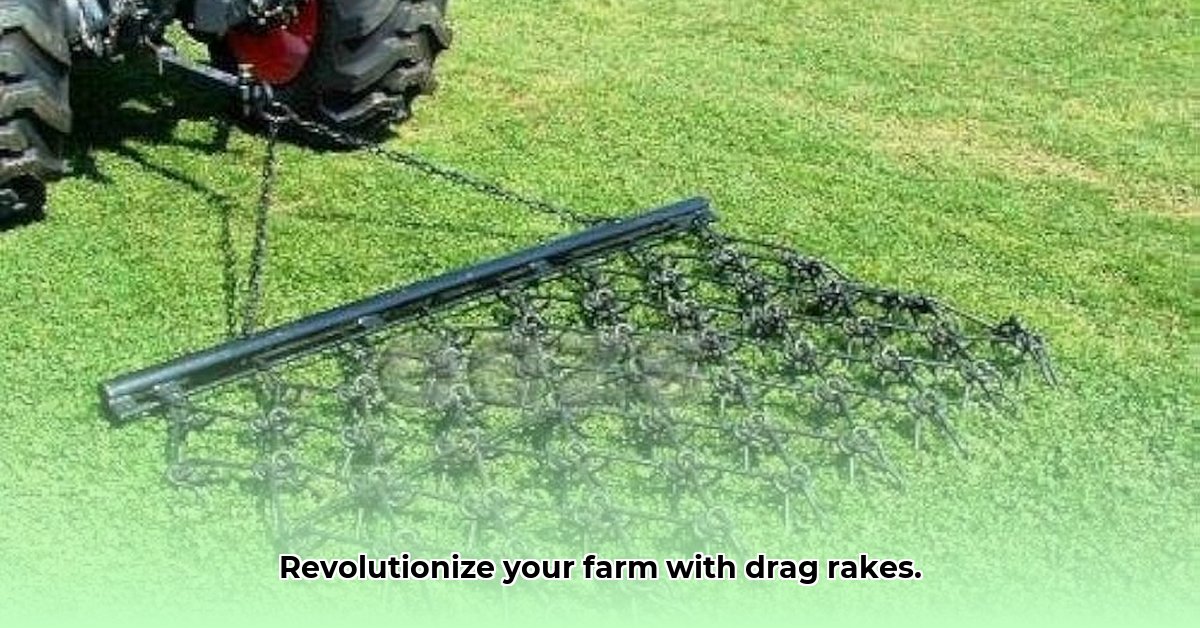
Tractor Drag Rakes: Your Guide to Healthier Soil and Sustainable Farming
Let's explore tractor drag rakes—unsung heroes of sustainable agriculture. While not flashy, they play a vital role in preparing soil for planting while minimizing environmental impact. This isn't simply about tool usage; it's about understanding your land and collaborating with nature. For more information on pull-behind rakes, check out this helpful resource: tractor supply rakes.
Understanding Your Soil: The Foundation of Success
Before using a drag rake, understand your soil's properties. Is it sandy and loose, or heavy clay? Soil type significantly impacts tillage techniques. Just as a wrong recipe ruins a cake, improper techniques harm crops and the environment.
Regular soil testing is crucial. It provides information on composition, pH (acidity/alkalinity), and nutrient levels – a health check for your land. This data guides decisions on fertilizer type and frequency, optimizing soil health. Healthy soil leads to thriving plants and a successful harvest. Isn't that the goal of every farmer?
Tractor Drag Rakes: A Gentle Approach to Soil Management
Tractor drag rakes are like sophisticated garden rakes for larger areas. They create even planting surfaces, break up soil clumps, and generally tidy the field. This gentle approach maintains soil structure, preventing erosion and nurturing beneficial soil microbes. These microbes improve soil quality and fertility.
However, over-tilling with any equipment, including a drag rake, is harmful. Excessive tillage disrupts soil structure, hinders water absorption, increases erosion risk, and kills beneficial microbes. The key is balance and soil type-specific procedures. How can you find the optimal balance? Precise data and experience.
Mastering Your Tractor Drag Rake: A Step-by-Step Guide
Ready to use your drag rake effectively and responsibly? Follow these steps:
Assess Field Needs: Does your field truly require tillage? Sometimes, leaving soil undisturbed is best. Over-tilling can negatively impact your yield.
Choose the Right Rake: Different rakes suit varying soil types and crops. A wider rake requires fewer passes, saving time and fuel.
Fine-Tune Settings: Adjust tines (teeth) and rake angle. Experiment to find the optimal setting for breaking up clods without excessive soil disturbance.
Determine Optimal Speed: Find the "Goldilocks" speed—not too fast, not too slow. Too fast, and the rake might skip areas. Too slow, and you risk soil compaction. This is experience-based and soil-dependent.
Constant Monitoring and Adaptation: Observe soil response. Adjust speed, rake settings, or approach based on your observations. Farming is a continuous learning process.
Post-Raking Inspection: After completion, inspect your work. Make any necessary corrections before planting.
Drag Rakes and Sustainable Farming: A Broader Perspective
Remember, drag rakes are one part of a larger sustainable farming strategy. Consider these practices alongside drag rake usage:
Cover Cropping: Planting cover crops prevents erosion and adds nutrients, like adding a protective blanket.
Crop Rotation: Rotating crops annually prevents pest build-up, disease, and nutrient depletion—similar to diversifying investments.
No-Till or Reduced Tillage: Whenever feasible, minimize tillage to preserve soil structure and organic matter. This is similar to letting the soil rest. Doesn't this benefit the entire ecosystem?
How to Use Drag Harrows for Sustainable Soil Management
Key Takeaways:
- Drag harrows provide a versatile, sustainable soil tillage method.
- Proper selection and usage minimize environmental impact.
- Choosing the right harrow type is crucial for soil health.
- Optimizing harrowing frequency improves efficiency.
- Understanding limitations is key to maximizing effectiveness.
Selecting the Appropriate Harrow
Choosing the right drag harrow depends largely on the soil type. Light, sandy soil is ideal for chain harrows; their gentler action minimizes soil disturbance. Heavier clay soils may need spike harrows for better penetration, but avoid compaction. Disc harrows, effective for thorough mixing, suit specific tasks and require more power. Choosing the right tool for the job is crucial; a hammer won't drive a screw!
Optimizing Harrow Usage for Sustainability
Effective harrowing depends on technique and timing. Over-harrowing risks soil erosion and compaction, while under-harrowing leaves pest control or seedbed preparation incomplete. It's about finding the right balance—not too much, not too little.
How to Use Drag Harrows for Sustainable Soil Management:
Assess Soil Conditions: Evaluate soil moisture and texture. Avoid working wet soil to prevent compaction and damage.
Select the Right Harrow: Choose based on soil type and goals.
Adjust Harrow Depth: Set depth appropriately. A shallower depth reduces disturbance. Deeper passes may be needed for weed control. How much disruption is ideal? It depends on your goals.
Control Tractor Speed: Maintain moderate speed (2-4 mph). High speeds lead to inefficiency and potential damage.
Monitor Soil Compaction: Regularly check for compaction and adjust to avoid harming soil structure.
Optimize Hallowing Frequency: 3-4 passes are typical, but adapt based on weather, weeds, and crop rotations.
Understanding the Limitations of Drag Harrows
While offering many benefits, drag harrows aren't a universal solution. They might not control deep-rooted weeds, and excessive use causes compaction. Combine them with other sustainable practices, like cover cropping, for a holistic approach. Isn't this a more effective strategy?
Pros and Cons of Drag Harrow Usage
| Advantage | Disadvantage |
|---|---|
| Versatile, multiple uses | Ineffective against deep roots |
| Relatively low cost | Potential for soil compaction |
| Low fuel consumption (with chain) | Can be labor intensive |
| Improves seed-to-soil contact | Can cause soil erosion (if misused) |